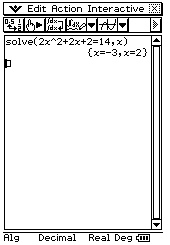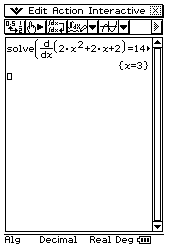Ok. Absolute value - easy enough, to take the absolute value of a number, make it positive if it wasn't already. easy peasy...
... until you start to look at IyI=IxI and ask students to graph it..
... then ask them to find the intersection of Ix-3I=I2x+4I algebraically
... then ask them to find Ix-3I<=I2x+4I
Students really bogged down when they reached inequalities. The approach I used was similar to that by Sadler in his
3A book for MAS. The problem was that I really wasn't sure they understood what they were doing.. they could follow the algorithm but understanding was eluding them.
I started by looking at absolute numbers and explained models for solving using number lines, graphing and algebraically. Then I used a composite approach to assist students visualise what it was they were doing with problems like:
Ix-3I<=I2x+4I
I started by displaying the graph on the board using the overhead gadget for the Classpad.
I entered Graph&Tab from the menu workpane (using the menu icon at the base of the workpane).
I selected Graph&Tab and entered Ix-3I for y1 and I2x+4I for y2. For some reason the graph workpane doesn't allow you to use the 2d tab absolute value option - so use the abs() function under the cat tab in the soft keyboard. When you hit enter it will restore the absolute value notation.
Make sure both y1 and y2 are ticked (if they are not place the cursor on the line using your stylus and hit exe). Hit the graph button in the toolbar (the first icon with the top formula pane selected). The following graph should appear:
We then looked at the original inequality again and I asked what did it really mean?
Ix-3I<=I2x+4I
One way of thinking about it was, "when is the graph y=Ix-3I less than or equal to the graph of y=I2x+4I?"
We looked at the graph and found that the part marked red on the line y=Ix-3I satisfied the inequality.
Using the intersect function under analysis in the menu bar we know that the two lines intersect at -1/3 and -7 therefore the interval is x<=-7, x>=-1/3.
We had discussed that we could also do this algebraically by using the property if IxI=IyI then x=y or x=-y to find the points of intersection.
Eg.
Ix-3I<=I2x+4I
x-3 = 2x+4
-x = 7
x=-7
x-3 = -(2x+4)
x-3=-2x-4
3x=-1
x=-1/3
I then asked students to draw a number line with the intervals marked and substitute the values back into the original inequality. We numbered the three intervals. The first interval represented x<=-7, the second -7<=x<=-1/3 and the last x>=-1/3.
We then selected a value within each of the intervals and substituted them into the inequality. If they were true then this indicated values of x that satisfied the inequality.
Ix-3I<=I2x+4I
Interval 1 (x=-8)
I-8-3I<=I2(-8)+4I
I-11I<=I-12I
11<=-12 (true)
Therefore x<=-7 is a valid interval.
Interval 2 (x=-5)
I-5-3I<=I2(-5)+4I
I-8I<=I-6I
8<=-6 (false)
Therefore -7<=x<=-1/3 is not a valid interval.
Interval 3 (x=0)
I-0-3I<=I2(-0)+4I
I-3I<=I6I
3<=6 (true) Therefore x>=-1/3 is a valid interval.
The inequality Ix-3I<=I2x+4I is valid over x<=-7, x>=-1/3
Drawing students attention from the graph and back to the algebraic representation released the tension in the room, the screwed up faces and suddenly lights went back on.
Thank goodness!
Here is a
link to other CAS calculator posts.

 Go keyboard -> 2D -> Calc ->
Go keyboard -> 2D -> Calc ->












